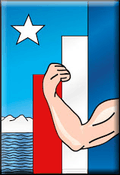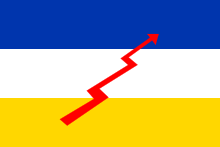National Socialist Movement of Chile
Movimiento Nacional Socialista de Chile was a political movement in Chile, during the Presidential Republic Era, which initially supported the ideas of Adolf Hitler, although it later moved towards a more local form of fascism. They were commonly known as Nacistas.[1]
National Socialist Movement of Chile Movimiento Nacional Socialista de Chile | |
|---|---|
 | |
| Leader | Jorge González von Marées |
| Founded | 5 April 1932 |
| Dissolved | 1938 |
| Succeeded by | Popular Socialist Vanguard |
| Membership | 20,000 (c. 1930's) |
| Ideology | Strasserism Corporatism Fascism Portalesism Populism |
| Political position | Nationalism |
| Party flag | |
 | |
Development
The movement was formed in April 1930 by General Diaz Valderrama, Carlos Keller (the main ideologue of the group) and Jorge González von Marées, who became leader. The party initially followed the ideas of Nazism closely, stressing anti-Semitism. It received financial support from the German population of Chile and soon built up a membership of 20,000 people. The movement stressed what it saw as the need for one party rule, corporatism and solidarity between classes, and soon set up its own paramilitary wing, the Tropas Nacistas de Asalto.[2]
However support for Hitler was later abandoned, with González von Marées claiming by the late 1930s that the use of the name 'national socialist' had been an error on his part. Anti-semitism was also scaled back, with a more domestic form of fascism being offered instead.[2] Indeed the main ideological inspiration claimed by the group was Diego Portales and the choice of name had to an extent been inspired by the success the Nazis were enjoying in Europe and a desire to tap into their, at the time, high reputation.[1] Initial contact with the NSDAP/AO eventually ended when that group criticised the Nacistas for their lack of commitment to anti-Semitism.[1] Individual members (most notably, Miguel Serrano) continued to look to Adolf Hitler.
Mergers
The party obtained three deputies (3,5% of the votes) during the 1937 parliamentary elections.[3] It then merged in 1938 with the Unión Socialista (Socialist Union) to create the Alianza Popular Libertadora (APL)[4] which supported General Carlos Ibáñez del Campo's candidacy for the 1938 presidential election. However, fascist elements attempted a coup in September 1938, which was ruthlessly put down at the Seguro Obrero massacre, and led Ibáñez to oppose the National Socialists' choice of Gustavo Ross, leading to indirect support of the Radical Party's candidate, Pedro Aguirre Cerda, who narrowly won the election.[5]
In 1939, some members of the APL created an offshoot, the fascist Vanguardia Popular Socialista, which failed to have any impact, and it was disbanded in 1941 whilst González von Marées was interned. On the other hand, the APL merged in 1945 with the Agrarian Party to form the Partido Agrario Laborista (PAL).
Of the former members of the party only Jorge Prat gained much influence. Publishing a weekly paper, Estanquero, between 1949 and 1954, he served as a cabinet minister in Carlos Ibáñez del Campo's government and attempted to run for President of Chile in 1964.[6]
See also
- Nazism in Chile
- Presidential Republic
References
- Max Paul Friedman, Nazis & Good Neighbours, Cambridge University Press, 2003, p. 52
- Stanley G. Payne, A History of Fascism: 1914-1945, London: Routledge, 2001, p. 341
- Cruz-Coke, Ricardo. 1984. Historia electoral de Chile. 1925-1973. Editorial Jurídica de Chile. Santiago
- Klein, Marcus (2001). "The New Voices of Chilean Fascism and the Popular Front, 1938-1942". Journal of Latin American Studies. 33 (2): 347–375. doi:10.1017/S0022216X01005995. ISSN 0022-216X. JSTOR 3653688.
- Payne, A History of Fascism, p. 342
- S. Cerqueira in JP Bernard et al., Guide to the Political Parties of South America, Harmondsworth: Penguin, 1973, p. 245
